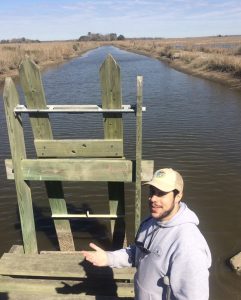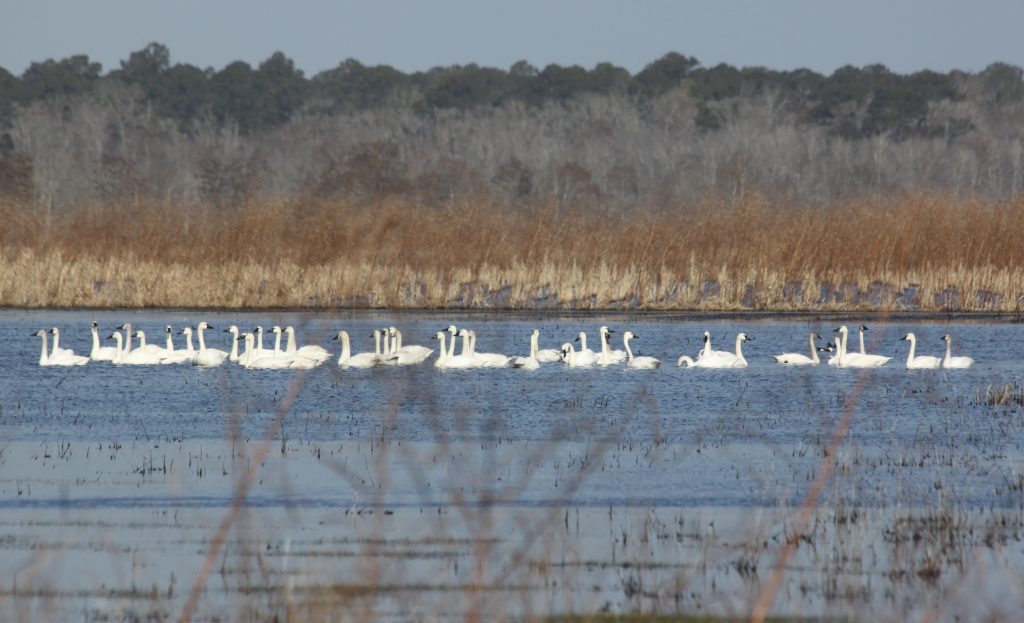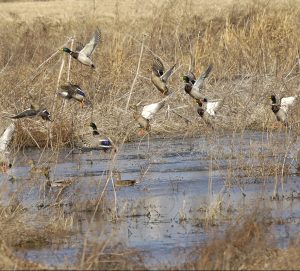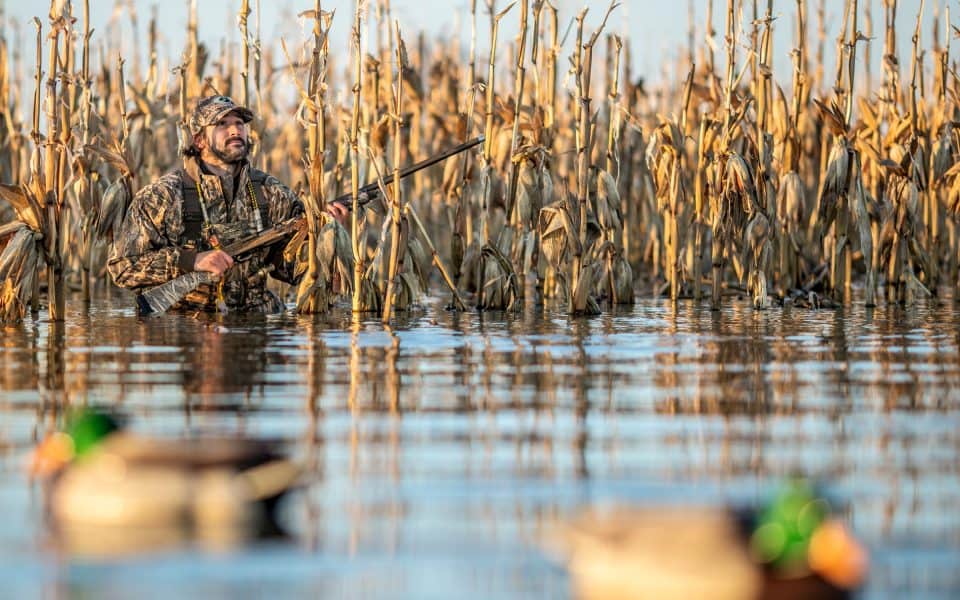Managing duck Impoundments requires a year-round cycle of monitoring, with the primary goal of growing a food crop and then flooding it. The fastest way to get ready to plant after duck season is to drain all the water from the impoundment, usually beginning on the first day after duck season ends. The process of draining takes time, because the wet ground will also need time to dry out before any kind of equipment can operate in the impoundment. However, anyone watching an impoundment after the gunfire ceases can witness the amazing array of birds that show up including raptors, wading birds and shorebirds.
A Gradual Drawdown

Jeff Dennis
Biologists in South Carolina and elsewhere have begun a switch to a gradual drawdown of that same water in spring in order to create a thin layer of water in the impoundment, known as “sheet water.” This stage of water level becomes a shorebird haven to fuel up on invertebrates, worms and such on their own migration to northern breeding grounds. The uneven ground at the bottom of any impoundment creates a topography of mounds and puddles that the shorebirds can easily navigate whether walking around or flying through the habitat. Essentially, this new management tactic gives more “biological bang” for your “waterfowl bucks.”
Along the Southeastern coastal plain, agriculture practices for Indigo and Rice production led to the creation of what are now modern waterfowl impoundments. Migratory waterfowl, shorebirds and wading birds all require various types of habitat with differing water depths, which are all controlled by the manipulations of the rice trunk (wooden sluices installed in “banks” or dikes of rice fields to control water levels). The first trunks used likely were as simple as a hollow tree trunk with some type of plug in it. Today, the use of trunks is still the gold standard on the impoundment landscape and manipulating water levels is both a science and an art form.
In South Carolina, the Department of Natural Resources (SCDNR) owns and operates the Bear Island Wildlife Management Area specifically for public draw waterfowl hunts. More than 5,000-acres of marshy low-lands, that were once agriculture impoundments now dedicated to wildlife. The array of birds that use the property yearlong is astonishing, which makes this property a crossover hit with non-hunters, too. However, Bear Island WMA is closed to the public during the entire waterfowl season which gives migratory ducks the rest time they require between hunt dates.
The day after duck season the front gate opens up to birdwatchers and to small game hunters. Remnant ducks such as the late migrating blue-winged teal abound. The SCDNR property is the perfect place to draw down to sheetwater and let the shorebirds feast, and that bird activity attracts other birds. Other winged visitors during the winter of 2022 at Bear Island included Tundra Swans, White Pelicans, Wood Storks, Roseate Spoonbills and multitudes of other avian life. The birds can scatter to their liking across 28 separate impoundments that range from 30-acres to 500-acres, all managed with tidal-flow trunks.

Jeff Dennis
Next door to Bear Island is privately owned duck hunting land where the main focus is attracting ducks to hunt during the season. A typical year begins getting the water off the impoundments as quickly as possible the day after hunting season ends. The quicker the fields are drained, the sooner maintenance practices can occur ahead of spring planting. The summer season growth of native panicum grasses can get started sooner, too, which can be manipulated in fall via burning to release seed for waterfowl. Flooding only occurs just before duck season opens, to avoid having corn crops devoured by migratory ducks before legal shooting time arrives.
While the rice trunk is a cost-effective management tool once in place, due to its simple design, the wooden structures do not last forever and the replacement costs for lumber and track hoe work are at all-time highs. Funds from the purchase of a hunting license can go towards maintenance on public lands (such as Bear Island WMA), but private property owners are saddled with them. If you factor in that a property will utilize multiple trunks with a lifespan of approximately 20-years, each requiring a coffer dam and bulkhead work when being replaced, then you understand the many challenges and costs facing impoundment managers and waterfowling enthusiasts.

Jeff Dennis
A recent scientific study in S.C. sought to locate historic rice impoundments that have been lost to time when the dike failed and the land reverted to a wild state. Using the new LIDAR technology, many inland impoundment sites were discovered, revealing arrow-straight ditches and canals that brought water to these areas presumably from creeks or holding ponds. LIDAR stands for Light Detection and Ranging, and uses light pulses from overhead to generate precise information about the surface characteristics below. These pulses penetrate the tree and ground cover that otherwise hide these formations from view.

Al Cheatham
The creation of upland impoundments in modern times is popular, especially with the popularity of duck hunting. Membership in a duck-hunting club can be a very satisfying way to spend time. The value of time spent afield isn’t just measured ducks bagged, it increases with each sighting of a bald eagle or some type of high-flying V of migratory waterfowl, and other views into the natural world. Which underscores how the combined effects of acreage under waterfowl management is having a tremendous positive effect for other species.
With studies showing that shorebirds are in decline, drawing down impoundments to benefit these shallow-water feeders is gaining popularity. The National Audubon Society owns a property named Silver Bluff along the Savannah River in S.C. that is well inland, and not far from the Savannah River Site nuclear facility. Audubon manages impoundments there but for traditional waterfowl usage.
Tim Evans is the Director of Land Conservation for Audubon in S.C. “In Spring we flood up in order to grow fish and invertebrates that attract migrating wood storks in August and September,” said Evans. “When we draw down water levels, vast numbers of shorebirds have begun showing up during their southward migration. Normally these shorebirds are observed closer to the coast, but the shorebirds are able to locate this food source and utilize it to fuel up during fall migration, which is an added bonus for anyone who visits here to view our wood storks.”
Witnessing this type of migration stopover activity, whether in spring or fall, makes one want to give thanks to the Creator for both the habitat and the wildlife that uses it in this symphony of flight. The fortitude of impoundment managers is tested each year by severe weather threats like flooding or drought, not to mention economic viability. Managers and observers are treated to nature’s fireworks when flocks of birds feed hard in impoundments. When they have cleaned out the food and move on, that’s the cue to return to the age-old practices in hopes to duplicate this same spectacle in one year’s time.
Jeff Dennis is a longtime outdoorsman. Read his blog at Lowcountry Outdoors.









